Doors 101
 Doors and locks for offices, classrooms and other facilities may not top anyone’s priority list. The same might be said of emergency lighting. But when support of campus safety and security is considered, their importance is undeniable. As a result, due attention to selecting, inspecting and maintaining doors and accompanying hardware, as well emergency lighting systems, seems a must for every institution. At the most fundamental level, this means assuring that vital components work together properly, according to Angelo Faenza, general manager of PERSONA and vice president, campus electronic access control for ASSA ABLOY.
Doors and locks for offices, classrooms and other facilities may not top anyone’s priority list. The same might be said of emergency lighting. But when support of campus safety and security is considered, their importance is undeniable. As a result, due attention to selecting, inspecting and maintaining doors and accompanying hardware, as well emergency lighting systems, seems a must for every institution. At the most fundamental level, this means assuring that vital components work together properly, according to Angelo Faenza, general manager of PERSONA and vice president, campus electronic access control for ASSA ABLOY.
“For the lock to work, whether mechanical or EAC locking device, the very basics of the door and frame being in sync with the locking device is critical,” he says. “Once you have that door and frame operating properly, the balance between life safety and security should always come down to how the institution is protecting its most precious asset — the students, faculty and staff.”
According to William Sporre, vice president, global sales and marketing for Marks USA, quality should take precedence over cost savings when it comes to investing in such equipment.
“There are no shortcuts in cost when choosing to maintain security hardware and provide life safety,” he says, noting that the use of Builders Hardware Manufacturers Association (BHMA) ANSI Grade One UL-listed hardware is essential. He adds that there are many choices in lesser-grade hardware, which might not satisfy code requirements.

PHOTO COURTESY OF KABA ACCESS & DATA SYSTEMS
SAFETY IS KEY. A functional and working key control system enhances campus security. Institutions should establish key control policies and procedures, and follow them. The purpose of the key policy is to protect the property and privacy of the college or university, and of individuals assigned to use university facilities, by limiting access to such facilities to assigned individuals and to their supervisors. The number of keys issued should be kept to a minimum, and a process for replacing lost keys should also be included.
“Certainly fire-rated doors that meet code are also essential, and a variety of functioning life-safety hardware merits consideration.” Examples include locksets for classrooms that allow instructors to lock the exterior lever in the case of emergency without going outside the classroom. Available in both cylindrical and mortise design, these products support safety and security while meeting building and fire codes.
Advance Planning
During initial construction, reaching out for the right technical expertise in proper product applications and code compliance is a key to success, according to Faenza.
“Get the specs, codes and compliance issues done at the time of preparing the specification which will lead to a proper door and hardware schedule,” he says. “Count on the respective experts in their field to help with this.”
He says this approach can head off problems, including added costs for measures such as having to retrofit a new door and frame before occupancy. “So many times a brand new door and frame are cut post-install and pre-occupancy because proper attention to application and compliance was not done correctly before bid,” Faenza says. “Do this early in the planning stages with the experts.”
While security is paramount, other factors should also be considered, depending on the needs of specific campus environments, says Dale Mathias, vice president of multi-housing sales for KABA Access & Data Systems.
“In a student housing environment, product design and finish is important,” he says. “The finish should be durable to withstand heavy use and abuse. And an antimicrobial finish can help control bacterial spread in enclosed heavily used environments.”
Once equipment is in place, focused maintenance efforts are recommended.
At the minimum, facilities staff should follow a regular maintenance plan that includes checking on vandalized hardware, upgrading to meet code changes and incorporating advancements in product design.
“Setting up appropriate project maintenance schedules is critical,” Faenza says. “Campuses generally
have excellent, well-trained and skilled tradesmen. It is less an issue of skill than whether the campus plans for it.”
Mathias adds that for both traditional and electronic equipment, scheduled maintenance is a key to forestalling problems.
“For electronic, battery-operated devices, set up maintenance schedules for battery change on an annual or semi-annual basis if necessary. And schedule door inspection throughout campus, especially cold environments, to insure proper closure and security where critical.”

PHOTO COURTESY OF ASSA ABLOY
Electronics and Lighting
In planning ahead, Mathias advises moving away from mechanical or hard-keyed equipment where possible.
“Always plan and budget for electronic access control in privatized or public student housing, study areas, research and public gathering areas for safety and security reasons,” he says.
Mathias notes that while hardwired systems can be effective, wireless security systems have become the logical next step for campus security.
“Wireless security has evolved and is a dependable technology today,” he says. “It is cost-effective and less than half the cost of traditional hardwired systems.”
With lighting, attention to security issues can also bring campus improvements. In some cases, the emphasis falls on back-up lighting for use during power failures. Whether relying on generators or battery back-up systems, these lights support safe egress from darkened buildings while also providing lighting for emergency workers.
Many schools are also utilizing blue emergency lights, with newer LED technology providing increased brightness and reducing energy consumption at the same time. When combined with easy-to-use call boxes, they enhance security in parking lots, along walkways and in other campus locations.
Certainly for doors, locks and related equipment, up-front efforts are almost sure to pay off in the long run.
“The door and frame and the accompanying hardware or access points are the one thing that no one notices until there is a problem,” Faenza says. “When there is a problem it is suddenly urgent, as it is the means by which people enter and leave buildings as well as their suite or office.”
In the end, he says, the use of high-quality hardware, doors, frames and access points, along with the work of properly trained trades staff, will go a long way towards heading off emergencies and promoting a secure campus.
Points to Ponder
In dealing with facilities-related security issues, choices are not always clear-cut. Here are three options worth pondering.
1. Glass or no glass? Doors constructed of glass, or of other materials with glass inserts, are popular on many campuses. But are they a good choice from a security viewpoint? Advocates point to the increased visibility that could allow security personnel or others to spot untoward activity more readily — and perhaps serve as a deterrent in the process. But others argue that they would provide less protection from a shooter or other intruder.
2. Who gets a master key? This may fall under the “nothing’s simple” adage. With traditional lock-and-key systems, it makes sense to limit the number of staff members who have access to master keys. But where should that line be drawn? Obviously, the fewer issued, the better. How can the best balance be achieved between security and convenience for building users, especially those with legitimate need for after-hours access?
3. How much is enough? With some lighting needs, a common view is the more, the better. But with emergency lighting, which by definition is infrequently used, the question arises as to the ideal level of resource dedication. Just how much should be invested in maintaining or updating emergency lighting systems? And how often should this be revisited?
This article originally appeared in the issue of .